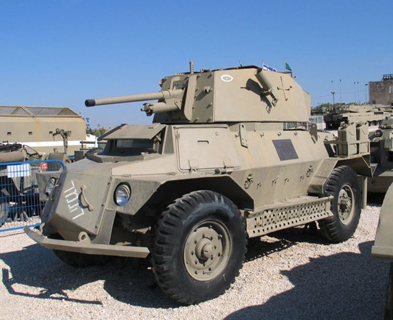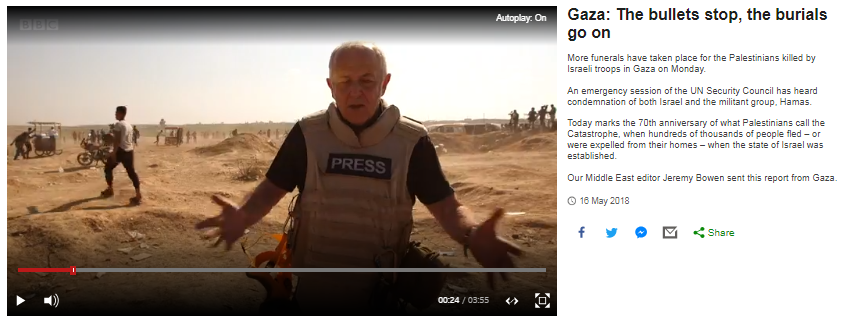h/t A
Earlier this month we noted a passage in an article which appeared in the Observer and was written by the commissioning editor of the BBC 4 documentary series ‘Storyville’, Nick Fraser. In that article Fraser wrote: 
“Think of other half-covered-up atrocities – in Bosnia, Rwanda, South Africa, Israel, any place you like with secrets – and imagine similar films had been made. Consider your response – and now consider whether such goings-on in Indonesia are not acceptable merely because the place is so far away, and so little known or talked about that the cruelty of such an act can pass uncriticised.” [emphasis added]
Thanks to a reader who wrote to Nick Fraser regarding his decision to broadcast the film ‘5 Broken Cameras’, some insight has now been gained into exactly which “half-covered-up atrocities” Fraser was thinking of when he wrote those words. Here is a part of his reply as it was received:
“First, I intend no slur in relation to Israel by referring to half-reported atrocities – you will notice that among those I noted in my piece was the British collusion in the Bengali famines, which was the work of British officials. The half-failure to acknowledge events is alas quite common – democracies are not immune to this trendency [sic]. Most Israelis would agree with me that the story of the massacre at Sabra and Chatila – not the work of Israeli soldiers – falls in this category. So, too, do the events that occurred in Lod in the war that occurred at the time of the founding of Israel – and the New Yorker excerpted an account from a book recently published.”
So, whilst Fraser is clearly aware that the Sabra and Shatila massacres were “not the work of Israeli soldiers”, he nevertheless did not see fit to include Lebanon on his list. He also elects to ignore the fact that Israel (unlike Lebanon) initiated a commission of inquiry into the events at Sabra & Shatila: a fact which clearly negates Fraser’s claim of a “half-failure to acknowledge events”.
But most revealing is Fraser’s citation of “the events that occurred in Lod” which, from his reference to the New Yorker, we can conclude he learned about from Ari Shavit’s book “My Promised Land: The Triumph and Tragedy of Israel” because the chapter of that book relating to Lod was indeed reproduced in that magazine in October last year.
However, Fraser does not seem to have sought out any additional information on the battle which took place in Lod (Lydda) in 1948 from other sources and he appears to have adopted Ari Shavit’s narrative as accurate despite the fact that – as noted in this review of Shavit’s book:
“The section on Lydda focuses on another nameless IDF “brigade commander.” The source notes claim these are composite characters, but it harms the narrative and makes it read like historical fiction.”
Other issues concerning Shavit’s book in general and his portrayal of the events in Lod in particular have been raised by Allan Gerson and Professor Ruth Wisse. Our colleague at CAMERA, Alex Safian, took the time to fill in the parts of the story not told by Ari Shavit – and hence presumably unknown to Nick Fraser.
“In Shavit’s very deceptive and even contradictory recounting, Israeli soldiers led by a certain Lt. Col. Moshe Dayan, and armed with:
a giant armored vehicle mounted with a cannon, menacing half-tracks, and machine-gun-equipped jeeps
joined other Israeli forces attacking Lydda (and its neighbor Ramle) during Israel’s War of Independence. Led by Dayan’s marauding forces the Israelis took control of “key positions” in the town, but the next day fighting flared again, and:
in thirty minutes, two hundred and fifty Palestinians were killed. Zionism had carried out a massacre in the city of Lydda.
Is this really what happened? Well let’s start with the matter of the “giant armored vehicle,” a phrase which could only stun anyone the least bit familiar with Israeli military history. It was actually just a lightly armored scout car – with regular inflated rubber tires – standing about seven feet high and just six feet wide. Here’s a picture of the actual vehicle, at the Israeli Armored Corps Museum at Latrun:

Read about the rest of Ari Shavit’s numerous – and more grave – distortions and omissions in this article.
Clearly, Fraser’s promotion of the notion of “half-covered-up atrocities” in Israel is based on the wobbly foundations of a half-covered-up story which he obviously did not bother to research fully before putting into the public domain, but which fits in with his already existing narrative. Rather like the commissioning process for ‘5 Broken Cameras’, it seems.
In the same reply Nick Fraser wrote:
“As for your observations about FIVE BROKEN CAMERAS, the film-makers would dispute them. The film appears to us to be an honest account of some aspects of the Israeli occupation. It doesn’t pretend to be other than what it is – a partial account from one side. And, importantly, one of the film-makers is an Israeli, and thge [sic] film has been widely shown in Israel. STORYVILLE, the series in which the film was shown, exists to show provocative, interesting films. Having read all accounts of the film – in Israel and elsewhere – we felt it was appropriate to show FIVE BROKEN CAMERAS.”
Fraser continued:
“We are showing THE GATEKEEPERS, another excellent Israeil [sic] film, later this year.”
What a surprise.




